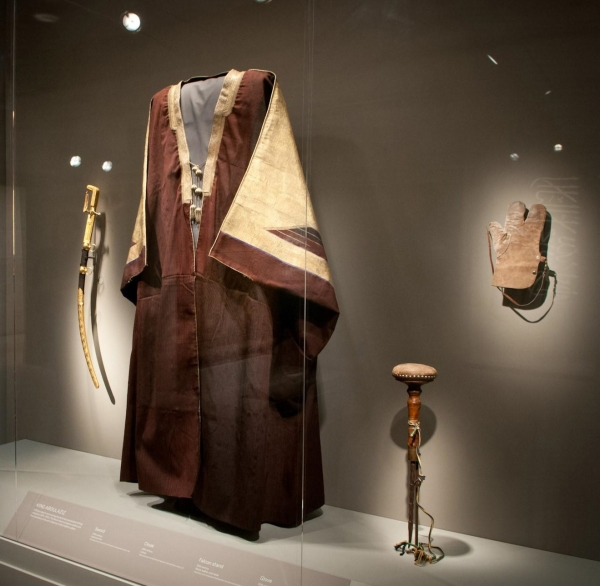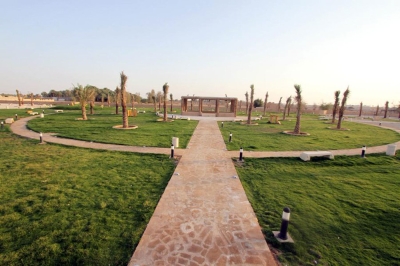

'Trade Routes in Arabia - Saudi Archeological Masterpieces Through the Ages' Exhibition is an international Saudi exhibition to introduce the world to the ruins of the Kingdom of Saudi Arabia and its cultural history extending back thousands of years. It was organized by the General Authority for Tourism and National Heritage (currently the Ministry of Tourism), with the participation of several local and international entities. The exhibition visited seventeen local and international stops, which included cities and capitals in Europe, Asia, and America, the first of which was the Louvre Museum in Paris in 2010.
The exhibition specializing in the Kingdom’s ruins and the civilizations of the Arabian Peninsula is the largest of its kind. During its several stops, it welcomed around five million visitors. It is highly publicized by the international media due to the importance of the artifacts it showcases that reflect the civilizational and cultural dimension of the Kingdom.
The exhibition displays various artifacts from finds collected from all provinces of the Kingdom through national and international excavation missions led by Saudi archaeologists. The list of artifacts includes about 460 pieces, representing the civilizations that settled in the Arabian Peninsula throughout the ages.
The displayed antiquities date back to different time periods, starting from the Paleolithic Age, and extending to one million years BC. Other time periods include the Ubaid period dated in the fifth millennium BC, then the Dilmun civilization, and the period of the early, middle, and late Arab kingdoms, in addition to the Islamic eras, until the era of the Saudi state three centuries ago, and the period of the Kingdom's unification. The contents of the exhibition were divided into three sections according to their historical sequence.
Artifacts in the Saudi Archeological Masterpieces Through the Ages Exhibition
Among the highlights of the Saudi Archaeological Masterpieces Through the Ages Exhibition is the 'Suffering Man' statue, which is made of sandstone, and is about six thousand years old. Another popular artifact is the 'Monument with the Eyes', a memorial stone with a human face engraved on it, dating back to the fifth century BC. Another artifact is the statue of the 'Lady of al-Faw', which is a bronze head of a woman dating back to the first century BC. This comes in addition to two bronze statues, the first of the Byzantine Emperor Heraclius, which is the only piece in the world that shows the emperor at a stage after the age of forty. The second statue depicts Harpocrates wearing the pschent of the pharaohs. Both statues were made in the period between the third century BC and the third century.
The exhibition showcases pieces related to the heritage of the Saudi State, representing aspects of social and cultural life, such as the possessions of the Founding King Abdulaziz Bin Abdulrahman Al Saud, dating back to the early twentieth century, including the flag of the Kingdom, a Mishlah (a traditional men’s cloak) and a Quran dedicated to King Abdulaziz. Other artifacts include the King's falcon hunting tools, such as a hand glove and a falcon cap, in addition to several pieces of folklore from the period of the unification of the Kingdom.
Local stops of the Saudi Archeological Masterpieces Through the Ages Exhibition
The Custodian of the Two Holy Mosques King Salman Bin Abdulaziz Al Saud opened the first local stop of the exhibition at the King Abdulaziz World Cultural Center 'Ithra' in Dhahran on December 1, 2016.
The exhibition was also organized at the National Museum in Riyadh as part of the exhibitions accompanying the first Antiquities Forum of the Kingdom, organized by the Saudi Commission for Tourism and National Heritage (formerly) under the patronage of the Custodian of the Two Holy Mosques King Salman Bin Abdulaziz from November 7 to November 9, 2017. The forum's exhibitions lasted over fifty days, during which about two hundred thousand visitors were welcomed.
European stops of the Saudi Archeological Masterpieces Through the Ages Exhibition
The exhibition began its first international stop at the Louvre Museum in Paris in 2010. The number of artifacts on display reached about three hundred pieces of various materials and ages. These were original pieces from various provinces of the Kingdom and were classified according to their historical sequence into three groups: pieces from prehistoric times, pieces from pre-Islamic times, and pieces from Islamic times. The second stop was at the Spanish La Caixa Foundation in Barcelona during the same year.
The third stop was at Russia's Hermitage Museum in 2011, then at the Pergamon Museum in Berlin in 2012. This stop displayed around four hundred artifacts. The exhibition traveled to American and Asian stops and returned to Europe for its launch in the 'Benaki Museum' in Athens in 2019.
Also in 2019, the exhibition was opened at the National Roman Museum in Italy, organized by the Saudi Commission for Tourism and National Heritage (formerly), with the participation of the Ministry of Culture in the Kingdom, and in cooperation with the Ministry of Cultural Heritage and Activities and Tourism of the Italian Republic. This marked the seventeenth stop of the exhibition, and it lasted three months.
American stops of the Saudi Archeological Masterpieces Through the Ages Exhibition
The United States of America hosted the Saudi Archeological Masterpieces Through the Ages Exhibition over two years across five museums in several states. The first stop was at the 'Sackler Gallery' in Washington in November 2012. In June 2013, it moved to the Carnegie Museum in Pittsburgh, Pennsylvania.
In December 2013, it moved to the Museum of Fine Arts in Houston, Texas. Moreover, the fourth stop was at the Nelson-Atkins Museum of Art in Kansas in April 2014. The fifth stop was at the Asian Art Museum in San Francisco, California, in October 2014.
Asian stops of the Saudi Archeological Masterpieces Through the Ages Exhibition
The first Asian stop of the exhibition was in Beijing, the capital of the People's Republic of China. It was launched on December 20, 2016, and lasted three months. The closing ceremony of the exhibition was held in the presence of the Custodian of the Two Holy Mosques, King Salman Bin Abdulaziz, and Chinese President Xi Jinping, on March 16, 2017, in conjunction with the activities of the historic visit of the Custodian of the Two Holy Mosques to the Chinese Republic.
Subsequently, the exhibition was hosted by the South Korean capital, Seoul, in 2017, and lasted for three months during which it displayed 466 artifacts. In 2018, it was inaugurated in Tokyo, in cooperation with the Japanese National Museum and the Saudi Embassy in Tokyo.
The exhibition moved to the Louvre Abu Dhabi in the United Arab Emirates during its fifteenth stop in 2018. Artifacts were added that reflect aspects of the living patterns of common civilizations in the Arabian Peninsula, related to the desert, equestrianism, camels, and falconry. The exhibition also included the pavilion of common heritage and civilizations between the Kingdom and the United Arab Emirates.
Related quizzes
Related articles
